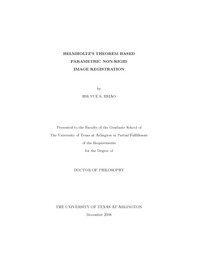| dc.description.abstract | Helmholtz's theorem states that, with suitable boundary condition, a vector field is completely determined if both of its divergence and curl are specified everywhere. Based on this, we developed a new parametric non-rigid image registration algorithm. Instead of the displacements of regular control grid points, the curl and divergence at each grid point are employed as the parameters. This leads to a very simple mathematical model - two Poisson equations in 2-D or three Poisson equations in 3-D which will be used to solve for the displacement field. The similarity measure is sum of squared difference. And multi-resolution is applied on the gradient descent optimization.In this dissertation, two closest related works are reviewed. The first one is the fast parametric elastic image registration which the parameters are the Bspline coefficients of the displacement field at each control grid point. However, in the fast parametric elastic image registration method, it is very likely to result in grid folding in the final deformation field if the distance between adjacent control grid points (knot spacing) is less than 8. This implies that the high frequency components in the deformation field can not be accurately estimated. Another relevant work is the parametric non-rigid image registration method based on Helmholtz decomposition. In that work, the deformation is considered as the result of two types of particles, namely the vortex particles and sink and source particles. Three types of parameters are associated with each particle: 1. the vorticity (curl) or divergence strength, 2. the influence domain, 3. position. Their method leads to a very complicated mathematic model and cannot be generalized to 3-D case easily. On the contrary, in our case, the divergence and curl, used as the only control parameters, are associated with each grid point. This leads to a very simple mathematical model and can be applied to 3D case easily.Though the present work does not guarantee the regularity (no mesh folding) of the resulting deformation field, it is rarely occurred in the practical case. However, to keep the completeness of the proposed method, we set the parameters as the divergence and curl of the B-spline coefficients of displacement field which further strengthen the regularization to be strong enough to warrant a folding free deformation field.In the experiments, we illustrate that the proposed method has the capability to handle various real medical images for both 2-D and 3-D. Also an experiment was devised to show the proposed method can overcome the aperture problem. | en_US |

